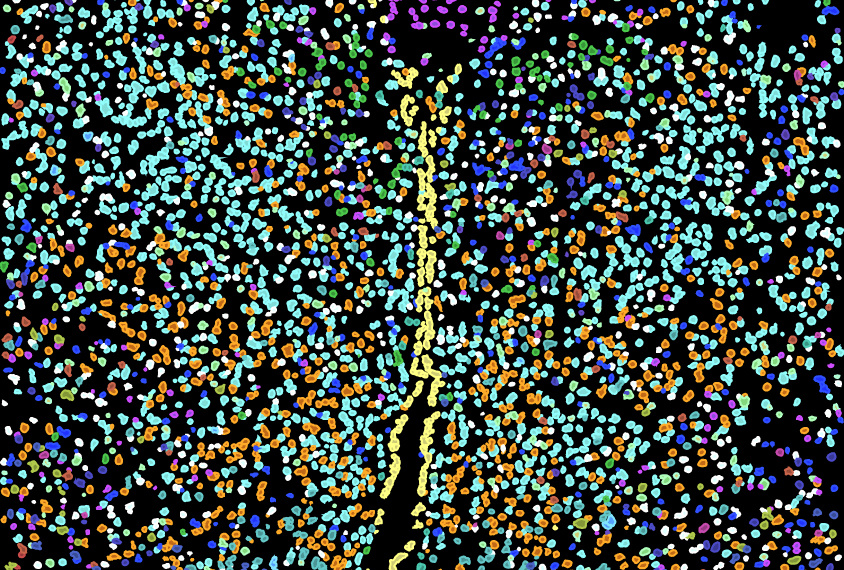
Gene expression ‘barcode’ maps cells in brain tissue
A new technique transforms the previous broad-brush picture of a brain region into a pointillist masterpiece of neuronal subpopulations associated with specific activities.
A new technique transforms the previous broad-brush picture of a brain region into a pointillist masterpiece of neuronal subpopulations associated with specific activities.
The method, called multiplexed error-robust fluorescence in situ hybridization (MERFISH), detects gene expression in intact tissue1. It uses DNA probes to tag individual RNA molecules inside brain cells with a fluorescent dye. The glowing molecules together form a ‘barcode’ that defines each RNA.
MERFISH can reveal the presence or absence of more than 150 RNAs at once; researchers use these data to identify cell types based on the cells’ patterns of gene expression.
Researchers presented the work Monday at the 2018 Society for Neuroscience annual meeting in San Diego, California. The study also appeared 1 November in Science2.
Identifying gene-expression patterns in an individual cell typically requires first isolating the cell from tissue. But MERFISH can be used in brain slices, enabling scientists to map the locations of different cell types within the brain.
The researchers used the technique to analyze more than 1 million cells in the preoptic region of the mouse hypothalamus. This area is involved in survival functions such as thirst, thermoregulation, mating and parental behavior.
The barcoding revealed 70 distinct cell types in this region — some of them previously unrecognized. For example, scientists already knew that neurons that express the signaling molecule galanin are involved in parental behavior; the new analysis sorted these neurons into 11 groups, each with a unique gene-expression profile.
“Each of these subtypes is transcriptionally distinct,” says Dhananjay Bambah-Mukku, a postdoctoral researcher in Catherine Dulac’s lab at Harvard University who presented the findings. “And they’re all in structurally diverse regions of the preoptic.”
Sex differences:
To probe the functions of the galanin subtypes, the researchers analyzed the brains of mice that had recently engaged in behaviors related to reproduction: mating, taking care of pups and male aggression toward pups or other males.
They tracked which cells show increased expression of c-FOS, a gene whose expression ramps up with neural activity. By mapping c-FOS to the MERFISH atlas, the researchers could define clusters of galanin neuron subtypes that are active during particular behaviors.
“The picture that emerges is that there are several cell types that are unique to each given behavior, but there are several cell types that are common to all the behaviors,” Bambah-Mukku says. The activity of some galanin subtypes also varies by sex.
For example, one cluster of galanin neurons is active in male mice while taking care of pups and during aggression, as well as in female mice during mating; another cluster is active only in female mice taking care of pups; and a third is active only during parental care, but in both mothers and fathers.
One advantage of the MERFISH technique is that it can detect genes expressed at low levels — for example, receptors for the social hormone oxytocin. These have been difficult to localize in the brain with other methods, but the researchers identified 19 clusters of cells in the preoptic region that express them.
For more reports from the 2018 Society for Neuroscience annual meeting, please click here.
References:
Recommended reading

Too much or too little brain synchrony may underlie autism subtypes

Developmental delay patterns differ with diagnosis; and more
Explore more from The Transmitter

This paper changed my life: Shane Liddelow on two papers that upended astrocyte research
Dean Buonomano explores the concept of time in neuroscience and physics

